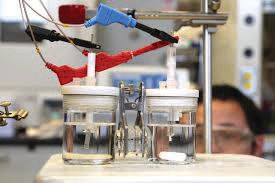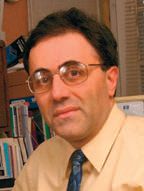Multimetal Catalyst for Producing Hydrogen
Dr. Neil Canter, Contributing Editor | TLT Tech Beat July 2016
A uniform amorphous catalyst produced by mixing three metals exhibits good performance and durability.
KEY CONCEPTS
• Combinations of multimetal oxides are under evaluation as catalysts used in splitting oxygen from water.
• A uniform homogeneous, multimetal oxide catalyst derived from chlorides of cobalt, iron and tungsten has now been prepared.
• The new catalyst displays three times the efficiency compared to other catalysts used as references.
DEVELOPING A PROCESS FOR EFFICIENTLY producing hydrogen fuel remains a major research goal to facilitate the use of fuel cells as a viable energy-producing device. One of the major problems in achieving this goal is to find a catalyst that can readily split oxygen from water in the oxygen-evolving reaction.
In a previous TLT article, an approach that is similar to photosynthesis was described for synthesizing hydrogen from water (1). Chemical modification of titanium dioxide combined with placing this material on a light-diffuse-reflected surface led to the demonstration that visible light can be used to catalyze water splitting. Initial work showed a photohydrogen yield one to two orders of magnitude higher than previously found.
One of the favored catalyst types used for evolving oxygen is metal oxides. Dr. Bo Zhang, postdoctoral fellow working with Ted Sargent, a professor in the department of Electrical & Computer Engineering at the University of Toronto in Toronto, says, “The objective is to identify a metal oxide that can best bind hydroxyl groups to a metal surface in a particular manner where the binding is not too weak so the catalyst is ineffective and the binding is not too strong which may block the catalysis. Finding the sweet spot is very difficult and has led researchers to look for combinations of metal oxides that can provide greater flexibility.” Zhang is the primary author on this new work, along with Xueli Zheng, a PhD student, and Oleksandr Voznyy, a research associate, both in professor Sargent’s group.
Researchers have used this method to determine that multimetal oxides based on transition metals such as iron, cobalt and nickel show promise in facilitating the oxygen-evolving reaction. But there is need to improve the performance of these catalysts.
A technique for improving catalyst performance is to introduce additional metal oxides in an effort to modulate the 3d outer valence shells of transition metal oxides. Zhang says, “Modulation involves changing the electronic structure of the multimetal oxides so that the binding distance between the metal oxide and oxygen can be adjusted in an effort to find the sweet spot and produce a more effective catalyst.”
After undertaking a theoretical analysis using density functional theory, the researchers found that the non-3d metal tungsten is particularly effective in modulating electron structures of the 3d transition metal oxides. Voznyy says, “Tungsten can form a number of oxidation states with the most common one being +6. This high oxidation state generates a large number of coordination sites that should be able to enhance modulation of the other metal oxides. Our theoretical analysis shows that tungsten will improve the ability of an iron, cobalt oxide system to split water.”
But there is a challenge to mixing different transition metal oxides together and producing a homogeneous mixture. Zheng says, “The problem is that if the metals are not next to each other on the Periodic Table, then mixing them is not possible because the different crystalline structures are not compatible.”
A different approach is needed to produce a uniform homogeneous, multimetal oxide mixture. Such a process has now been developed leading to a new catalyst with potentially very promising performance characteristics.
GELLED MULTIMETAL OXIDE CATALYST
The catalyst is prepared by mixing chloride derivatives of the three metal oxides in an organic solvent. Zhang says, “We mixed chlorides of cobalt, iron and tungsten in ethanol and hydrolyzed them in a room temperature.”
The researchers realized that each of the metal chlorides will be hydrolyzed at a different rate. In an effort to produce a homogeneous distribution of cobalt, iron and tungsten, very low concentrations of water and propylene oxide are used to ensure that each metal chloride reacts in a similar manner.
To evaluate the catalyst, the resulting amorphous metal oxyhydroxide gels are supercritically dried with carbon dioxide. The researchers used a variety of analytical techniques to verify the structure of the gelled multimetal oxide catalyst.
Zheng says, “Scanning transmission electron microscopy showed that a uniform amorphous phase is produced with a crumpled and entangled nanosheet and nanopore structure that does not contain a crystalline phase. This structure is confirmed by x-ray diffraction and inductively coupled plasma optical emission spectroscopy revealed that the molar ratio of iron:cobalt:tungsten is 1:1.02:0.70, respectively.”
The gelled multimetal oxide catalyst is evaluated on a glassy-carbon electrode that contains one molar potassium hydroxide as the electrolyte (Figure 3). Reference materials used in the study include gelled iron cobalt, layered double hydroxide iron cobalt and amorphous iron cobalt tungsten.

Figure 3. A gelled multimetal oxide catalyst displayed higher efficiency than other reference catalysts when evaluated in the experimental set-up shown. (Figure courtesy of the University of Toronto.)
The gelled multimetal oxide catalyst exhibited over three times the efficiency as compared to any of the other catalysts. In addition, this catalyst has demonstrated excellent durability in showing no signs of degradation after 500 hours of continuous activity. Other comparable catalysts do not show comparable durability.
Zhang says, “We are currently evaluating additional transition-metal types in an effort to develop more effective catalysts. Our objective is to identify industrial applications for these catalysts.”
Additional information on this research can be found in a recent article (2) or by contacting Sargent at ted.sargent@utoronto.ca.
REFERENCES
1. Canter, N. (2015), “Hydrogen fuel formation,” Tribology and Lubrication Technology, 71 (11), pp 12 – 13.
2. Zhang, B., Zheng, X., Voznyy, O., Comin, R., Bajdich, M., Melchor, M., Han, L., Xu, J., Liu, M., Zheng, L., Arquer, F., Dinh, C., Fan, F., Yuan, M., Yassitepe, E., Chen, N., Regier, T., Liu, P., Li, Y., Luna, P., Janmohamed, A., Xin, H., Yang, H., Vojvodic, A. and Sargent, E. (2016), “Homogeneously dispersed multimetal oxygen-evolving catalysts,” Science, 352 (6283), pp 333 – 337.

Neil Canter heads his own consulting company, Chemical Solutions, in Willow Grove, Pa. Ideas for Tech Beat can be submitted to him at neilcanter@comcast.net.